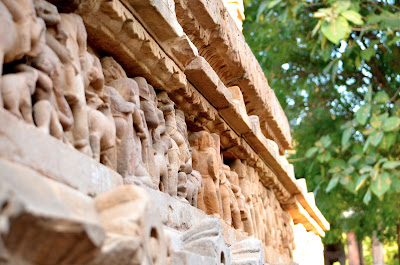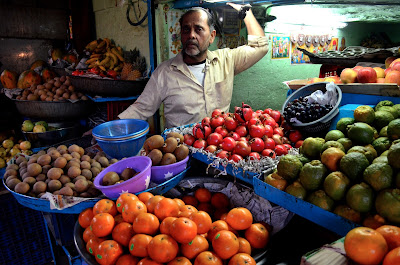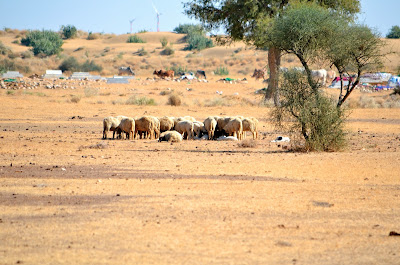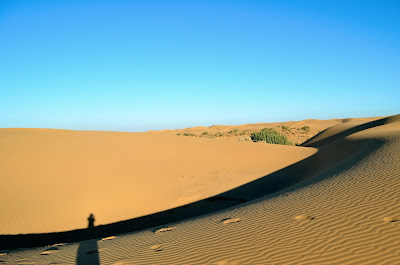Before I came to India, before I started working at Guria, poverty seemed to me like a pretty cut and dry concept. Obviously, dealing with poverty is far from simple. But poverty itself is something that we, in the 21st century, with our news stories, expose movies and books, causes, organizations and statistics, is something that we've come to believe we all intellectually understand. It means lack of money, lack of opportunities. It means old clothing and poor living conditions. It means a dearth of food and a constant struggle to make ends meet. But since arriving at Guria, I've realized that, although we all know a lot of handy key phrases to describe poverty, these phrases stunt our understanding, making it bland and shallow.
At Guria's Non-Formal Education center, I teach computer and English class to the older girls. Computer class, to most, brings up memories of fooling around on Mavis Beacon, or maybe to some, learning more advanced computer functions. But at Guria, computer class means learning how to turn on and off a computer, to double-click with the mouse, to open a new folder and to type, at this stage, less than ten words per minute. From the beginning, I was struck by the fact that, before Guria got computers, these kids had never seen a computer in their life. Things that are obvious to us, so obvious that we don't even realize they are pieces of knowledge to be known or not known - things like knowing when the computer is on or off, understanding that the mouse controls the cursor on the screen, grasping the concept of files and folders and two files not being able to have the same name - are completely foreign to them. Suddenly I began to see the depth behind the hackneyed soundbyte that poverty is lack of opportunity. For these kids, it means never being able to work a job that requires you to go anywhere near a computer. It means never being able to use a computer in any of the many ways we use them every day. Imagine never using a computer again, imagine a job for which you'd never need to touch a computer-like device. For us, in America, imagining that goes beyond even the power of our well-trained imaginations. It was only last week, as we were reviewing how to turn on and off the computers, that I thought to ask how many of the kids have electricity in their homes. The answer? About half the kids who we are teaching how to use computers aren't even used to using electricity.
In English class, I go around the room, asking questions like, "what's your name?", "where are you from?", and "how old are you?". The other day was the first time I'd ever seen anyone stumble in response to the question "how old are you?". It was the first time I'd ever seen someone consult their friends about their age and come up with an answer only after a bit of disagreement. Although the questions and answers are supposed to be in English, the discussion about the girl's age was not an error in translation, it was all in Hindi. That is not nearly as common a phenomenon as not having any idea how to use a computer - the former I've witnessed only once, while the latter applies to all the kids at Guria - but it taught me just as much about poverty, and exponentially more than statistics or theses ever could.
One of the other volunteers at Guria once told me that perhaps the biggest impediment to the childrens' education is their lack of encouragement at home. It has been jarring for me to hear how many times the girls have told me that they aren't smart enough or can't do something - and to see how quick they are to give up when faced with a difficult classroom assignment. It's weird to see them rebuff compliments with responses of "no, I'm not smart," or "no, that wasn't good." But the flipside to that are some of my happiest moments at work. When we started English classes, some of the girls weren't interested, some didn't think it was worth the effort, and most had no faith in the English that they had learned thus far. Now, they all jump for the chance to be the one answering questions in class and clap joyfully when they get things right. Sometimes I'll be teaching computer class and suddenly hear, floating over from the other side of the room, "where are you from?", "I'm from India, where are you from?", and listen joyfully while they go through their entire repetoire of questions and answers. There are girls that insist they don't know enough English to answer my questions, but I insist that I'll help them through the answer, and somewhere in the process, they realize they can do it and suddenly, they're hungry to learn more.
They may know more English than they knew - or thought they knew - four months ago, but it's not the English phrases they can now say that make me happy. It's their excitement, their enthusiasm, their desire to learn, and, most importantly, their pride in what they have learned, that make up my happiest moments. I couldn't possibly teach them enough English to make a difference in their futures, but I couldn't ask for anything better than the ability to inspire them to want to learn and to challenge themselves, and most of all, to believe in themselves that they can face the challenges.
At Guria's Non-Formal Education center, I teach computer and English class to the older girls. Computer class, to most, brings up memories of fooling around on Mavis Beacon, or maybe to some, learning more advanced computer functions. But at Guria, computer class means learning how to turn on and off a computer, to double-click with the mouse, to open a new folder and to type, at this stage, less than ten words per minute. From the beginning, I was struck by the fact that, before Guria got computers, these kids had never seen a computer in their life. Things that are obvious to us, so obvious that we don't even realize they are pieces of knowledge to be known or not known - things like knowing when the computer is on or off, understanding that the mouse controls the cursor on the screen, grasping the concept of files and folders and two files not being able to have the same name - are completely foreign to them. Suddenly I began to see the depth behind the hackneyed soundbyte that poverty is lack of opportunity. For these kids, it means never being able to work a job that requires you to go anywhere near a computer. It means never being able to use a computer in any of the many ways we use them every day. Imagine never using a computer again, imagine a job for which you'd never need to touch a computer-like device. For us, in America, imagining that goes beyond even the power of our well-trained imaginations. It was only last week, as we were reviewing how to turn on and off the computers, that I thought to ask how many of the kids have electricity in their homes. The answer? About half the kids who we are teaching how to use computers aren't even used to using electricity.
In English class, I go around the room, asking questions like, "what's your name?", "where are you from?", and "how old are you?". The other day was the first time I'd ever seen anyone stumble in response to the question "how old are you?". It was the first time I'd ever seen someone consult their friends about their age and come up with an answer only after a bit of disagreement. Although the questions and answers are supposed to be in English, the discussion about the girl's age was not an error in translation, it was all in Hindi. That is not nearly as common a phenomenon as not having any idea how to use a computer - the former I've witnessed only once, while the latter applies to all the kids at Guria - but it taught me just as much about poverty, and exponentially more than statistics or theses ever could.
One of the other volunteers at Guria once told me that perhaps the biggest impediment to the childrens' education is their lack of encouragement at home. It has been jarring for me to hear how many times the girls have told me that they aren't smart enough or can't do something - and to see how quick they are to give up when faced with a difficult classroom assignment. It's weird to see them rebuff compliments with responses of "no, I'm not smart," or "no, that wasn't good." But the flipside to that are some of my happiest moments at work. When we started English classes, some of the girls weren't interested, some didn't think it was worth the effort, and most had no faith in the English that they had learned thus far. Now, they all jump for the chance to be the one answering questions in class and clap joyfully when they get things right. Sometimes I'll be teaching computer class and suddenly hear, floating over from the other side of the room, "where are you from?", "I'm from India, where are you from?", and listen joyfully while they go through their entire repetoire of questions and answers. There are girls that insist they don't know enough English to answer my questions, but I insist that I'll help them through the answer, and somewhere in the process, they realize they can do it and suddenly, they're hungry to learn more.
They may know more English than they knew - or thought they knew - four months ago, but it's not the English phrases they can now say that make me happy. It's their excitement, their enthusiasm, their desire to learn, and, most importantly, their pride in what they have learned, that make up my happiest moments. I couldn't possibly teach them enough English to make a difference in their futures, but I couldn't ask for anything better than the ability to inspire them to want to learn and to challenge themselves, and most of all, to believe in themselves that they can face the challenges.












































